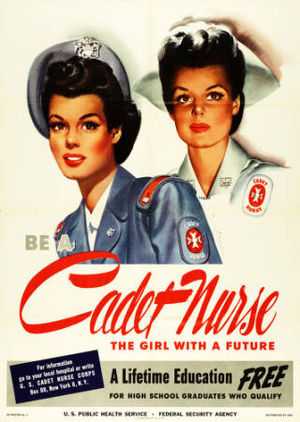Cadet Nurse Corps

The Cadet Nurse Corps program was passed by Congress unanimously and became effective on 1 July 1943. The corps was supervised by the United States Public Health Service (PHS) to train 124,000 young women as nurses during World War II, including 3000 blacks. After America entered the war the demand for nurses increased dramatically, outstripping the supply and creating a shortage. The plan was to subsidize over 1000 nursing schools for a three-year training program after which they graduates could, if they wished, become commissioned officers in the Army or Navy nurse corps. The war ended before the first Cadets graduated and few entered the military.[1] In its lifetime 1943-48, it was the largest training program in the History of nursing in the United States.
History
The instructional staff and facilities of the existing civilian schools of nursing needed to be strengthened. The plan conceived to do so contemplated that nursing students would receive accelerated training, and their services would be used even while still in training. Thus, a larger number of graduate nurses could be freed for military service overseas. And it meant that civilian and military communities on the home front would receive substitute-nursing care by student nurses. An emergency measure was considered faster and more economical than reinstituting the Army School of Nursing, or building similar military schools based in hospitals.
The plan became concrete when Representative Frances P. Bolton of Ohio introduced her bill on March 29, 1943. The bill requested the establishment of a special government program to facilitate the training of nurses. Applicants would be granted subsidization of nursing school tuition, associated expenses, and a shorter training period. In exchange, applicants pledged to actively serve in essential civilian or other federal government services for the duration of the war. In addition, the bill would provide certain funds for participating, accredited schools of nursing. This measure intended to ensure that as many schools as possible would take part in the Cadet Nurse Corps program.
The Nurse Training Act (known as the Bolton Act) passed Congress unanimously. The bill was signed by President Roosevelt on June 15, 1943, and became Public Law 74 on July 1, 1943. The Cadet Nurse Corps (originally designated the Victory Nurse Corps) would be administered by the United States Public Health Service (PHS). The Division of Nurse Education was established in the PHS to supervise the Cadet Nurse Corps and answerable to the US Surgeon General, Thomas Parran, Jr.. He appointed Lucile Petry, a registered nurse (RN), director of the Cadet Nurse Corps
To qualify, the women were required to be between the ages of 17 and 35, a high school graduate or a college student, in good health and mentally alert. Advertisements for the "war job with a future" promised free training with pay, room and board, and uniforms ("There's one for summer and one for winter, and it's hard to say which is the smarter, which you'll wear with more pride"). Applicants were assured they could wear "something frilly and feminine" for dances, and they would have time for dating.[2]
Nursing schools throughout the country were informed of the Cadet Nurse Corps program and invited to join. Schools who wanted to take part in the program had to fulfill minimal requirements. They had to be accredited, and affiliated with a hospital approved by the American College of Surgeons. The staff and the facilities had to be adequate, but superior standards were not required. Schools with substandard conditions were not rejected, but supported with funds from the Corps to improve their training possibilities. When the Cadet Nurse Corps program ended in 1948,[3] 1,125 of the 1,300 nursing schools in the country had participated.
References
- Cadet Nurse Corps history and WWII women's uniforms in color — WWII US women's service organizations (WAC, WAVES, ANC, NNC, USMCWR, PHS, SPARS, ARC, and WASP)
- ↑ Video: Allied Drive On In Italy--Planes Smash Foe In Air Etc. (1944). Universal Newsreel. 1944. Retrieved February 21, 2012.
- ↑ "Serve your Country in the "war job with a future"... (advertisement)". Life. 1944-01-24. p. 31. Retrieved November 11, 2011.
- ↑ United States Cadet Nurse Corp Exhibit http://www.rochestergeneral.org/about-us/rochester-general-hospital/about-us/rochester-medical-museum-and-archives/online-exhibits/united-states-cadet-nurse-corps-1943-1948/
Further reading
- Bonnie Bullough, "The lasting impact of World War II on nursing." AJN The American Journal of Nursing (1976) 76#1 pp: 118-124.
- Beatrice J. Kalisch and Philip A. Kalisch. "Nurses in American History The Cadet Nurse Corps-in World War II" AJN The American Journal of Nursing (1976) 76#2 pp: 240-242
- Heather Willever nd John Parascandola, "The Cadet Nurse Corps, l943-48." Public Health Reports (1994) 109#3 pp: 455-57. online